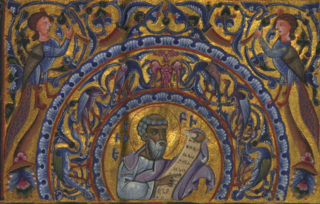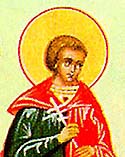
Eusebius of Caesarea, also known as Eusebius Pamphilus, was a Greek Syro-Palestinian historian of Christianity, exegete, and Christian polemicist. In about AD 314 he became the bishop of Caesarea Maritima in the Roman province of Syria Palaestina. Together with Pamphilus, he was a scholar of the biblical canon and is regarded as one of the most learned Christians during late antiquity. He wrote Demonstrations of the Gospel, Preparations for the Gospel and On Discrepancies between the Gospels, studies of the biblical text. As "Father of Church History", he produced the Ecclesiastical History, On the Life of Pamphilus, the Chronicle and On the Martyrs. He also produced a biographical work on Constantine the Great, the first Christian Roman emperor, who was Augustus between AD 306 and AD 337.

April 1 - Eastern Orthodox liturgical calendar - April 3
Saint Pamphilus, was a presbyter of Caesarea and chief among the biblical scholars of his generation. He was the friend and teacher of Eusebius of Caesarea, who recorded details of his career in a three-book Vita that has been lost.

The Diocletianic or Great Persecution was the last and most severe persecution of Christians in the Roman Empire. In 303, the emperors Diocletian, Maximian, Galerius, and Constantius issued a series of edicts rescinding Christians' legal rights and demanding that they comply with traditional religious practices. Later edicts targeted the clergy and demanded universal sacrifice, ordering all inhabitants to sacrifice to the gods. The persecution varied in intensity across the empire—weakest in Gaul and Britain, where only the first edict was applied, and strongest in the Eastern provinces. Persecutory laws were nullified by different emperors at different times, but Constantine and Licinius' Edict of Milan in 313 has traditionally marked the end of the persecution.

Euphemia, known as the All-praised in the Eastern Orthodox Church, was a virgin martyr, who died for her faith at Chalcedon in 303 AD.

Romanus of Caesarea, also known as Romanus of Antioch, is venerated as a martyr. A deacon of Caesarea, he was martyred at Antioch.

The persecution in Lyon in AD 177 was an outbreak of persecution of Christians in Lugdunum, Roman Gaul, during the reign of Marcus Aurelius, recorded in a contemporary letter preserved in Eusebius's Ecclesiastical History, book 5, chapter 1, which was written 150 years later in Palestine. Gregory of Tours also describes the persecution in the 6th century in De Gloria martyrum.

Aphian is venerated as a martyr by the Catholic Church and by the Eastern Orthodox Church. He is said to have died during the persecutions of the Emperor Galerius on April 2 in or around the year 305. In the Eastern Orthodox calendar, his feast thus falls on April 2, along with Edesius (Aedisius), who is sometimes called his brother.

Julia of Corsica, also known as Julia of Carthage, and more rarely Julia of Nonza, was a virgin and martyr who is venerated as a saint. The date of her death is most probably on or after AD 439. She and Devota are the patron saints of Corsica in the Catholic Church. Julia was declared a patroness of Corsica by the church on 5 August 1809; Devota, on 14 March 1820. Both were martyred in pre-Christian Corsica under Roman rule. Julia's feast day is 23 May in the Western liturgical calendar and 16 July in the East.
Elias and four companions, Daniel, Isaiah, Jeremiah, and Samuel were Egyptian martyrs. Their feast day is February 16.

Christians were persecuted, sporadically and usually locally, throughout the Roman Empire, beginning in the 1st century AD and ending in the 4th century. Originally a polytheistic empire in the traditions of Roman paganism and the Hellenistic religion, as Christianity spread through the empire, it came into ideological conflict with the imperial cult of ancient Rome. Pagan practices such as making sacrifices to the deified emperors or other gods were abhorrent to Christians as their beliefs prohibited idolatry. The state and other members of civic society punished Christians for treason, various rumored crimes, illegal assembly, and for introducing an alien cult that led to Roman apostasy. The first, localized Neronian persecution occurred under Emperor Nero in Rome. A more general persecution occurred during the reign of Marcus Aurelius. After a lull, persecution resumed under Emperors Decius and Trebonianus Gallus. The Decian persecution was particularly extensive. The persecution of Emperor Valerian ceased with his notable capture by the Sasanian Empire's Shapur I at the Battle of Edessa during the Roman–Persian Wars. His successor, Gallienus, halted the persecutions.
Saint Aedesius of Alexandria was an early Christian martyred under Galerius Maximianus. He was the brother of Saint Aphian. According to the martyrology, he publicly rebuked a judge who had been forcing Christian virgins to work in brothels in order to break them of their faith, so he was tortured and drowned.

Christina of Bolsena, also known as Christine of Bolsena, or in the Eastern Orthodox Church as Christina the Great martyr, is venerated as a virgin martyr of the third century. Archaeological excavations of an underground cemetery constructed over her tomb have shown that she was venerated at Bolsena by the fourth century.
Sossianus Hierocles was a late Roman aristocrat and office-holder. He served as a praeses in Syria under Diocletian at some time in the 290s. He was then made vicarius of some district, perhaps Oriens until 303, when he was transferred to Bithynia. It is for his anti-Christian activities in Bithynia that he is principally remembered. He was, in the words of the Cambridge Ancient History, "one of the most zealous of persecutors". While in Bithynia, Hierocles authored Lover of Truth, a critique of Christianity. Lover of Truth is noted as the first instance of the trope, popular in later pagan polemic, of comparing the pagan holy man Apollonius of Tyana to Jesus Christ.

Saints Alphaeus and Zaccheus were two Christians who were put to death in Caesarea, Palestine, in 303 or 304, according to church historian Eusebius in his Martyrs of Palestine. They are commemorated on November 18.

Saint Timolaus and five companions, according to the historian of the early Christian church Eusebius in his Martyrs of Palestine, were young men who, having heard that the Roman authorities in Caesarea, Palestine, in 303 AD, had condemned a number of Christians to die by being thrown to wild beasts in the public arena, came before the governor of their own volition with their hands tied behind their backs and demanded to join their fellow Christians in that martyrdom. They were not however thrown to wild beasts but decapitated along with two other men who were already in prison.
The Acts of Carpus, Papylus, and Agathonice is a martyrdom account about three Christians traveling through Pergamum until they are discovered by the pagan authority of the city and put to death by them. The date of the text is disputed amongst biblical scholars. Either from the second century AD of Marcus Aurelius's reign or the third century AD of Decius's reign.
Saints Meuris and Thea were two Christian women who were martyred at Gaza, Palestine. Their feast day is 19 December.
Saint Ulphianus was a Christian martyr in Palestine. His feast day is 3 April.

This article lists historical events that occurred between 301–400 in modern-day Lebanon or regarding its people.













